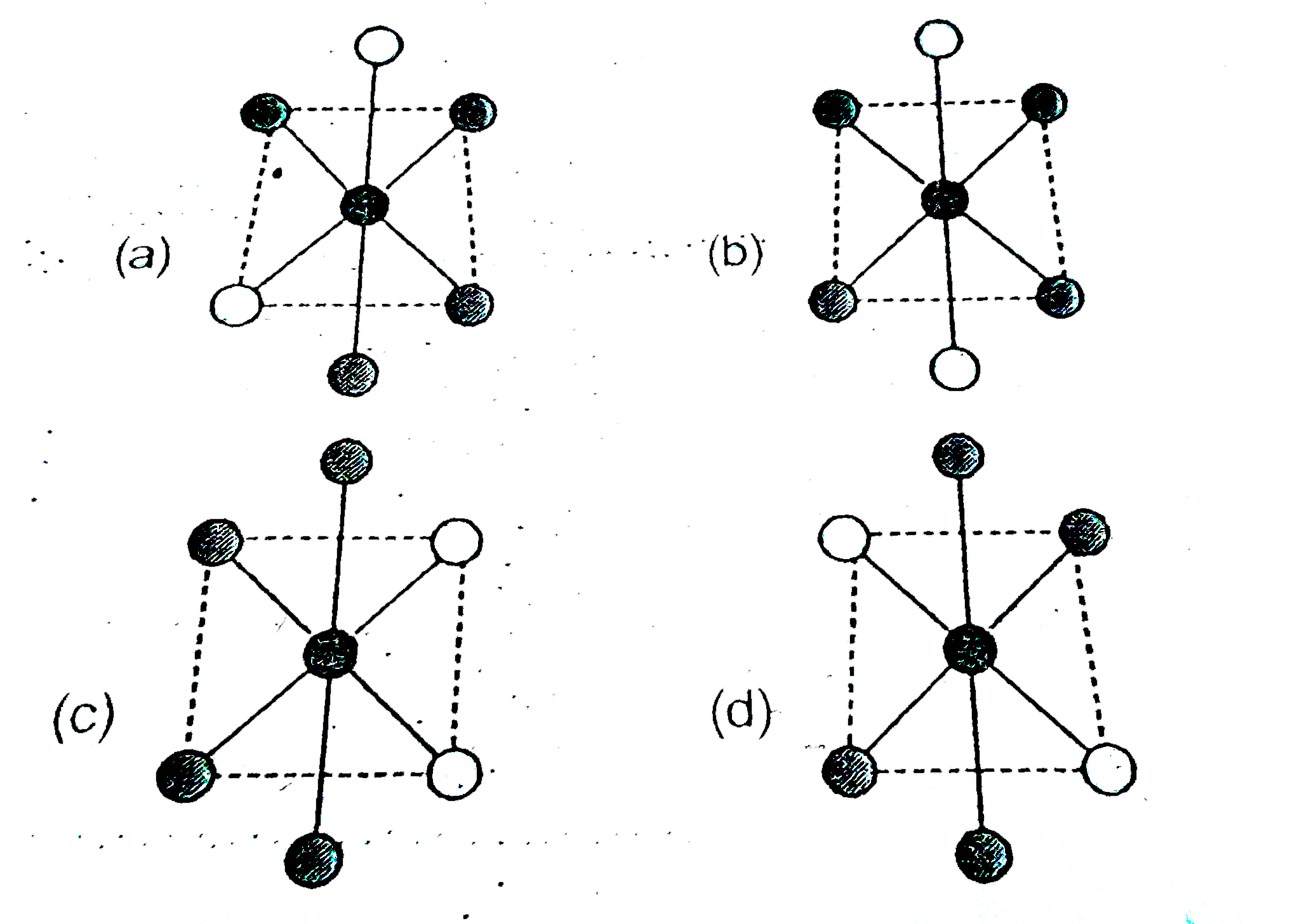Consider the following reaction and statements:
[Co(NH3)4Br2]++Br−→[Co(NH3)3Br3]+NH3
(I) Two isomers are produced if the reactant complex ion is a cis-isomer.
(II) Two isomers are produced if the reactant complex ion is a tran-isomer.
(III) Only one isomers is produced if the reactant complex ion is a tran-isomer.
(IV) Only one isomers is produced if the reactant complex ion is a cis-isomer.
The correct statements are :
(III) and (IV)
(II) and (IV)
(I) and (III)
(I) and (IV)
The correct Answer is:D
To solve the problem, we need to analyze the given coordination compound reaction and the statements regarding the isomers produced. The reaction is as follows:
(Co(NH3)4Br2)++Br−→(Co(NH3)3Br3)+NH3
Step 1: Identify the reactant complex ion
The reactant complex ion is (Co(NH3)4Br2)+. This complex can exist in two forms: cis and trans.
Step 2: Analyze the cis isomer
1. Cis Isomer: In the cis configuration, the two bromide ligands are adjacent to each other.
2. When one NH3 ligand is replaced by a Br− ion, two types of isomers can be formed:
- Facial Isomer: All three Br ligands are adjacent to each other.
- Meridional Isomer: The Br ligands are arranged such that two are opposite each other, and one is adjacent.
Thus, two isomers are produced from the cis isomer.
Step 3: Analyze the trans isomer
1. Trans Isomer: In the trans configuration, the two bromide ligands are opposite each other.
2. When one NH3 ligand is replaced by a Br− ion, only one type of isomer can be formed:
- Meridional Isomer: Since the Br ligands are already opposite each other, replacing any NH3 will lead to a configuration that results in only the meridional isomer.
Thus, only one isomer is produced from the trans isomer.
Step 4: Evaluate the statements
- Statement I: True - Two isomers are produced if the reactant complex ion is a cis-isomer.
- Statement II: False - Two isomers are not produced if the reactant complex ion is a trans-isomer (only one isomer is produced).
- Statement III: True - Only one isomer is produced if the reactant complex ion is a trans-isomer.
- Statement IV: False - Only one isomer is produced if the reactant complex ion is a cis-isomer (not true).
Conclusion
The correct statements are I and III.
Final Answer
The correct statements are: I and III.
The reactant complex ion is (Co(NH3)4Br2)+. This complex can exist in two forms: cis and trans.
1. Cis Isomer: In the cis configuration, the two bromide ligands are adjacent to each other.
2. When one NH3 ligand is replaced by a Br− ion, two types of isomers can be formed:
- Facial Isomer: All three Br ligands are adjacent to each other.
- Meridional Isomer: The Br ligands are arranged such that two are opposite each other, and one is adjacent.
1. Trans Isomer: In the trans configuration, the two bromide ligands are opposite each other.
2. When one NH3 ligand is replaced by a Br− ion, only one type of isomer can be formed:
- Meridional Isomer: Since the Br ligands are already opposite each other, replacing any NH3 will lead to a configuration that results in only the meridional isomer.
- Statement I: True - Two isomers are produced if the reactant complex ion is a cis-isomer.
- Statement II: False - Two isomers are not produced if the reactant complex ion is a trans-isomer (only one isomer is produced).
- Statement III: True - Only one isomer is produced if the reactant complex ion is a trans-isomer.
- Statement IV: False - Only one isomer is produced if the reactant complex ion is a cis-isomer (not true).
The correct statements are I and III.
The correct statements are: I and III.
Topper's Solved these Questions
- COORDINATION COMPOUNDSBOOK - RESONANCE ENGLISHCHAPTER - COORDINATION COMPOUNDSEXERCISE - Exercise-3 Online Exam
22 Videos
- COORDINATION COMPOUNDSBOOK - RESONANCE ENGLISHCHAPTER - COORDINATION COMPOUNDSEXERCISE - Additional Problem for Self Practice (APSP) Part-I
29 Videos
- COORDINATION COMPOUNDSBOOK - RESONANCE ENGLISHCHAPTER - COORDINATION COMPOUNDSEXERCISE - Exercise-3 Part-I: JEE(Advance ) /IIT-JEE Problem (Comprehenion )
1 Videos
- CHEMISTRY IN EVERYDAY LIFEBOOK - RESONANCE ENGLISHCHAPTER - CHEMISTRY IN EVERYDAY LIFEEXERCISE - ORGANIC CHEMISTRY(Chemistry in every day life)
31 Videos
- D & F BLOCK ELEMENTSBOOK - RESONANCE ENGLISHCHAPTER - D & F BLOCK ELEMENTSEXERCISE - ORGANIC CHEMISTRY(Aldehydes , Ketones, Carboxylic acid)
15 Videos
Similar Questions
Knowledge Check
Consider the following isomers.
(i) [Pt(NH3)4Cl2]Br2 (ii)[Pt(NH3)4Br2]Cl2
(iii) [Co(NH3)4Cl2]NO2
Which of the following observations is correct ?A(i) will give a part yellow and (ii) will give a white precipitate with AgNO3 solution .B(iii) will give a white precipitate with AgNO3 solution .C(i) , (ii) and (iii) will give white precipitate with AgNO3 solution .DNone of the above isomers will give white precipitate with AgNO3 solution .Which of the following will have a trans isomer?
A B
B C
C D
D
In the reaction
[CoCl2(NH3)4]⊕→[CoCl3(NH3)3]+NH3, only one
isomer of the complex product is obtained. Is the initial complex cis or trans ? .
View Solution[CoCl2(NH3)4]++Cl−→[CoCl3(NH3)3]+NH3. If in this reaction two isomers of the produt are obtained, which is true for the iniital (reactant) complex:
View Solution[CoCl2(NH3)4]++Cl−→[CoCl3(NH3)3]+NH3. If in this reaction two isomers of the produt are obtained, which is true for the iniital (reactant) complex:
View SolutionWhich one of the following complexes will have six isomers ?
View SolutionConsider the following isomers of [Co(NH3)4Br2]+ . The black sphere represent Co, grey spheres represent NH3 and unshaded spheres represent Br.

Which of the following are cis-isomers ?
View SolutionGive the number of total possible ionisation isomers in [Pt(NH3)4CI2]Br2 .
View Solution
